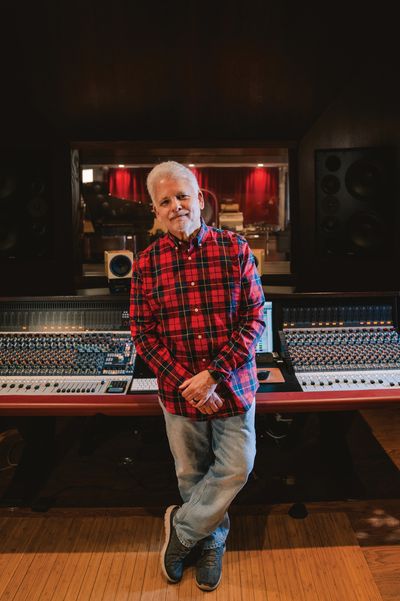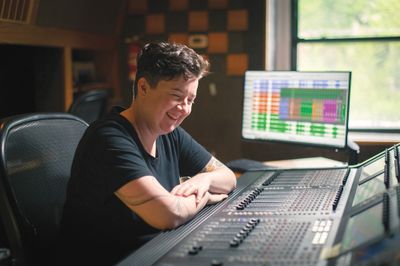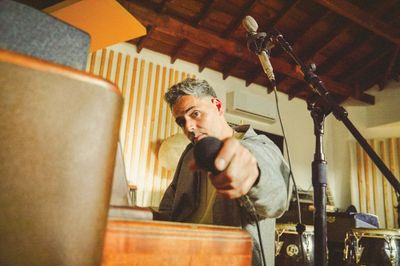Inside a 1073
The Neve 1073 modules consist of three main features: a mic preamp, a line amp and a three-band EQ section with a hi-pass filter. In original 1073s, the mic preamp and the line amp have separate, and differently designed, input transformers that are essential to the big, musical sound. A transformer is a device that transfers electrical energy from one circuit to another through inductively coupled wire coils. Transformers introduce a certain amount of coloration to audio signals, and the saturation characteristics of a transformer are determined by various factors, including the materials used and the winding structure of the coils. Neve's transformers are revered for the sonic girth and punch they add to whatever signal runs through them. In a British console in the '70s, the balancing of inputs and outputs was done with transformers, so you ended up with a separate mic input transformer and line input transformer. The sonics of the mic input transformer would be captured to tape and then the line input transformer would add it's own magic during playback and mixing. This cumulative layering of color on every track is a big part of what makes a record tracked and mixed on a vintage Neve console sound the way it does.
Orphans
In the early 1990s, as affordable digital recording gave rise to countless project and home studios, people realized the value of taking a Neve preamp or two out of a console and racking them up for home use. Smaller companies like Brent Averill Enterprises (BAE) started to do just this, selling original Neve modules racked up with proper power supplies. They also discovered that another multi-purpose line amp module in the 80-series consoles, the acclaimed and often misunderstood 1272, could be modified to act as a mic preamp that contained nearly the same guts as a 1073 (more on the 1272 in a bit). Modules that were once members of large families were, in a word, orphaned.
Clones
It was only a matter of time before companies, like AMS Neve, BAE, Chandler Ltd. (issue #46), Shep Associates, Vintech and more, started building Neve- inspired preamps and EQs, and we quickly entered what Bob Power (owner of an amazing array of orphaned Neve modules, see issue #60) calls "the second golden age of pro audio." Transformers were still being manufactured by Carnhill (after changing its name from St Ives) or they were being copied and manufactured to vintage specs, complex EQ switches were being soldered by hand and classic circuits were studied and re-created to bring us that vintage Neve sound. When you buy a clone of the 1073, you're getting all of the features, components and build- quality of the original. And, as you might guess, clones are expensive, ranging from about $2500 on up toward $4000/channel. Serious stuff.
Imitation
Soon, a number of companies jumped on the coattails of all this Neve enthusiasm and, by changing and/or eliminating various features of the original designs, started to sell more affordable Neve imitations. One could now buy a preamp that sounded more or less like a Neve for under $1500 per channel. These are the units I'm focusing on here. One obvious way to cut cost is to eliminate the EQ section, leaving the user with a simple Neve-style mic preamp and DI. Another strategy is to eliminate the line amp's transformer and electronics path by routing line level signals through the mic input with a pad (BAE), by reverse wiring the mic input transformer (Vintech), by eliminating the line amp transformers (AMS Neve) or just skipping line inputs entirely (JC). Still another way to drastically cut costs is to use less-expensive transformers, switches, wire and capacitors. These component downgrades will impair the sound of Neve-style circuits, but have also allowed companies like Golden Age and Chameleon Labs to offer truly affordable Neve-style preamps. In turn, these affordable units have led to some very successful and commercially available modifications (ZenPro, CL). I've done my best to help you see under the hood of these units in order to make the most informed decision you can about what you're actually purchasing. Think about how you work and what you need. If you're a mixer without a console, you may want to run your mixes through a fat sounding pair of line amps in order to pick up some analog console-style mojo. If you're planning to use your preamps to manipulate individual sounds on recording or mixdown, you may want the best EQ available. If you're a keyboard or bass player, you may want a pair of great sounding DIs. If you're only going to track vocals, perhaps you just need a great mic preamp. Knowing how you'll use a Neve- style preamp will give you the best sense of how to choose from among the various offerings.
In Review
Most Neve-style preamps (remember, not exact clones) happen to fall under the $1500/channel price point, so I let the market itself draw that line in the sand. I should also note that though there are many Neve-style offerings available for the very popular 500-series format, I've excluded them because they often run on lower voltage (which can affect the headroom and sound of the preamps) and because you'd need to get a 500-series rack to power them. That's a good topic for another shoot out, but beyond the scope of what we're considering here.
As the shipping boxes showed up at my studio, I began to spend time with all the units during daily tracking and mixing, and getting to know them as part of my normal work-flow. This is the best way for me to learn how a piece of gear sounds and feels to use. However, one day I put an AKG 414 on my guitar amp, plugged in my Telecaster and played a familiar riff over and over while my assistant patched in the different preamps and hit record. (These fed my Crane Song HEDD converter into Pro Tools HD at 96 kHz/24-bit.) Because I'm so familiar with this classic guitar tracking method, it was instantly apparent what the different pres sounded like up against each other. Strengths and weaknesses I'd heard in regular, daily use were quickly confirmed, as each unit imparted its sonic character on the same signal. It didn't take long to get a grip on what each of these units could do.
The Lineup
AMS NEVE 1073DPA — This stereo preamp quickly became the benchmark for the rest, and it sounds absolutely amazing on everything you throw at it. It has a size and richness that's as good as any of the vintage Neves I've used, and it held its own against all of the preamps in this shoot out. If you want the Neve sound, this one has it. As some of the other preamps here do, the 1073DPA utilizes Carnhill transformers that best match the characteristics of the original 1073s, and I can attest to the sweet coloration curve as you bring up the gain. Very nuanced, very big, very Neve. To keep costs down, the 1073DPA forgoes an unbalanced DI, and the line level inputs do not have dedicated transformers. However, line level signal are not routed through the mic input transformer either, a unique design among the units tested. Due to this, the line inputs were very open and far less colored than 1073s with transformer balanced line inputs. Surprisingly, I liked the line level inputs so much that I mixed an entire album through them (by routing the DPA between the output of my summing mixer and before my bus compressor), achieving a big open sound with the added heft of the beefy output transformers. Vocals tracked with a vintage Telefunken U47 through this pre were stunning, and on the guitar riff shoot out, this preamp sounded muscular, detailed and three-dimensional. With no DI and no EQ, you're paying for top-end transformers, great build quality and — let's face it — a little extra for the name brand. If all you need is a killer preamp and an excellent line-input device with a big open sound, you can't beat the DPA. (Thanks to Jeff Leibovich from Vintage King who arranged an extended loan of the AMS Neve so I was able to truly benchmark all of the other preamps against it.) ($2995 MSRP; www.vintageking.com, www.ams-neve.com)
VINTECH X73i, 273, 473 — Vintech has been making relatively affordable Neve clones in their X73 and X81 for years. With the X73i, 273 and 473, they've moved into the Neve-style market. These three models feature the same preamp section with 70 dB of gain, but there are variations on the EQ. The X73i has a full-featured 1073 style EQ that sounds very good. It falls a tiny bit short on the high- band, which can be a bit harsh when really cranked up, but the mids and lows are bang-on. The 273 (2 channels) and 473 (4 channels) use only the high and low shelf bands of the EQ, cutting costs while still offering what Vintech calls "Essential EQ." To keep costs down, these preamps use non-concentric EQ switches and route all DI and line level signals through the mic pre section via a switch that sends the signal into the mic transformer in reverse (that means no separate line input transformer and amp). Perhaps because of these cost-cutting design features (and due to some needless criticism of Vintech's gear by certain wily characters who inhabit certain Internet forums), I kind of expected to hear these preamps perform beneath the standard set by the AMS Neve and the BAE models. Wow, was I wrong! The Vintechs are just as muscular, articulate, three-dimensional and punchy as any of the pres I tried, and they were shockingly close to the AMS Neve in the guitar-riff shoot out. I immediately heard how these units and their bigger cousins have managed to fool seasoned engineers in blind tests. The DI sounds very good, though lacked some of the liveliness and heft I heard in the BAE models (see below). Running line level mixes into the Vintechs offered up more color than the AMS Neve, as we might expect when running into the mic pre's input transformer. Sending a mix through them made the low end punchier, the mids a bit darker and rounded the top end — very Neve-ish, but not as open or plush as dedicated line inputs can be on originals and their clones. With the X73i, 273 and 473 you get a lot of kit for your money, and if you're looking for a 1073-style preamp with a full-featured EQ, the X73i is an unbeatable deal. As a note, Vintech has changed transformers, so depending on the vintage of the unit you will either get a Carnhill or a new custom-made American transformer designed to be more like the Marinars found in the original Neves — sonically, there's not much difference. These Vintechs are big, solid, heavy professional units capable of holding their own among the best Neve-style preamps on the market. Don't let the critics fool you! (X73i $1350 street, 273 $1700, 473 $2900; www.vintech-audio.com)
BAE 1073MP & 1073MPF — These units really began their development when Brent Averill started tweaking orphaned Neve 1272 modules, so let's take a moment to consider the 1272. These 1272s were "bus amps" found in Neve consoles, yet they used the same input and output transformers as well as the same input and output gain stages as the 1073 mic preamp. However, the 1272 used one preamp stage that, in combination with the output stage, topped out at 50 dB of gain while the 1073 incorporated a second preamp gain stage and pad network to provide net gains higher than 50 dB. To be clear, the 1272 is considered a two-stage preamp (input and output) and the 1073 is considered a three-stage preamp (two input stages and one output stage). This three-stage circuit and the elaborate switching involved are a big part of why original 10-series mic preamps and their clones are so expensive. That one gain switch on the 1073 controls switchable pad networks throughout the circuit, routes the internal signal path, and varies the actual gain of the main preamp stage. That's a lot of work for one switch. But a 1272 was so close to a 1073 — it just needed more gain. In order to add gain beyond 50 dB to orphaned 1272 modules, various people began tweaking circuits, and these tweaks are played very close to the chest. We should note that by squeezing gains above 50 dB out of the two-stage preamp, 1272s will sound different at higher settings. You may get more noise and compromise the bandwidth when working above 50 dB, a possible limitation for ribbon mic enthusiasts and those recording quieter sources, but probably not important for those recording sources such as loud rock, pop or hip-hop.
Brent Averill was perhaps the most notable 1272 tweaker, and you can still find orphaned 1272s that he racked in studios around the world and for sale on the used market. By the late '90s the buzz about orphaned 1272 modules was out — and as original modules became increasingly rare — companies like Vintech and BAE began building 1272-style clones. Over the years BAE has tweaked their 1272 clones and recently renamed them the 1073MP (mic pre) and 1073MPF (mic pre with filter). Technically, though, these are still two-stage preamps, but with proprietary circuit tweaks that achieve 70 dB of gain with constant impedance to retain the same noise-floor and sound throughout all gain settings. These units are generously loaded with Carnhill transformers and hand-wired circuits that belie their price point. Peek under the hood and you'll see the same top- shelf components and point-to-point wiring you'd see in BAE's best Neve clones. As you might expect, the preamps really nail the Neve sound with a big, muscular tone that's rich with harmonic complexity and detail. They're just a touch darker in the upper mids than the AMS Neve and the Vintechs, making for a slightly sweeter coloration curve as you drive them — a bit creamier, you might say — and this quality is what many people look for in a Neve-style preamp. On the guitar riff shoot out the BAEs were among the very best, delivering full-on rock tone with in-your-face 3D realism. The DI sounds big, warm and solid, especially on electric bass, and you'll appreciate the front-panel 1/4'' inputs. To handle line level these units use the mic inputs with a pad (there is only one XLR input per channel). Running a mix through these units adds a fair amount of color — a bit more than the Vintechs and way more than the AMS Neve. The BAE line inputs smooth the top end, thicken the mids and add some weight to the lows. For in-the-box mixes suffering from "digititis," this could be just the box to mellow things out. The 1073MPF includes the high-pass filter from the BAE 1073, a unique and welcome feature that makes dialing out rumble and other low-end manipulations a click away. If you want uncompromised, thick Neve tones from your mic pre, a killer DI, and the ability to color line level signals with Carnhill transformers and hand-wired circuits, the 1073MP and MPF are one of the best deals out there. (1073MP single-channel w/ power supply $1100, 1073MPF single-channel w/ power $1450, dual-channel versions available; www.baeaudio.com)
JC1272 — Joel Cameron (JC) has devised a very unique (and secret) approach to getting extra gain out of his 1272-style circuit. Furthermore, his approach to gain manipulation is unique. By separating the pad from the gain switch, Joel was able to put a separate, continuously variable attenuator before the gain control, allowing the user to manipulate the gain stages in ways previously impossible. The result? — a totally unique take on the Neve preamp that allows you to dial in everything from standard-issue Neve sounds to cleaner tones with less color to complete solid- state fuzz. With no EQ, no line inputs and the distinction of being the only unit without a phase reverse switch, the JC1272's three knobs are solely focused on shaping tone via gain manipulation. Joel loads the JC1272 with specially designed Carnhill transformers, and this hand-wired beauty sounds as good as any Neve-style preamp I've ever tried — wow! When you dial it in to sound like a Neve, it produces rich, bold, fat sounds that hold their own against any of the best clones and originals out there. In the guitar-riff shoot- out I was stunned by how my Tele seemed to jump straight out of the speakers and into the room. Huge, 3D, musical tone! Then we manipulated the gain stages to get squished fuzz, more hi-fi open sounds, and many tones in-between. I'm accustomed to the set-it-and-forget-it Neve gain switch, so the JC1272 requires a little more attention in use. The DI, which is activated by plugging in a 1/4" cable on the front, is hearty and punchy. Because the JC1272's unique gain network stops at 65 dB of gain, low output ribbon mic enthusiasts should take note. However, if you don't need an EQ or line-inputs, but want a boutique-grade preamp with unsurpassed tone that can do classic Neve sound and a whole lot more, this is your preamp. (www.jc1272.com)
GOLDEN AGE PROJECT PRE-73 — When I heard that there was a Chinese-made Neve-style preamp available for $300, I expected to find the pro audio equivalent of Cheez Whiz. I was wrong. First of all, this is a heavy, all metal, half rack unit loaded with transformers (yeah, yeah — they're Chinese), and it's the only unit without an EQ that has a separate line input transformer and circuit. The switches feel robust, the red paint is thick and the whole package feels like something costing four times as much. It's pretty cool for the money. Where the PRE-73 falls short, though, is on sound. The tone lacks the 3D quality I've been going on about with the other units, and the PRE- 73 seems to veil the details in the upper mids and highs that define a sound. Comparatively, my guitar riff lacked interest as you couldn't hear as much of the Tele's string and wood, and the bass response wasn't as punchy. But, for only $300 it does have a very Neve-ish tone. It's full-bodied, thick and saturated, not pristine and neutral like so many preamps in this price range. If you don't have much to spend and want to step up your prosumer interface's game with some rock 'n' roll preamp coloration, the PRE-73 is easily the best offering in this class. When you consider that you're getting a fully transformer-balanced preamp with a distinct line-input circuit, a decent DI and a very Neve-like tone for what you'd pay in tax on a fully cloned preamp, it's a bit of a marvel. Perfect for the home or project studio, but perhaps not for the pro studio with discerning clients. ($299 street; www.goldenageproject.com)
GOLDEN AGE PRE-73 with FULL ZENPRO MOD — ZenPro Audio offers two mods to the PRE-73: one replaces all the capacitors with original Neve- value pieces and the output transistor with a new-old-stock Motorola 2N 3055 for $129, and the second includes an upgrade of the mic input transformer and the output transformer to Carnhills for $349 (but leaves in the stock line- input transformer). The unit I tested had the full mod, so we're talking about an otherwise unoccupied price point of $600 per channel. The improvement in sound is huge, basically lifting the veil off of the tone and revealing the details I was missing without the mod. My guitar riff sounded way more complex and, at the same time, fuller, fatter and bolder. The tone is not as big and exciting as the more expensive units in this shootout, but the PRE-73 with the ZenPro Mod fills a big void in the line-up with its reasonable price and excellent, very Neve-like sound. The final call on this mod is that while it doubles the price of the GA PRE-73 it easily quadruples the sound, making it a no-brainer for anyone who already owns a PRE-73 or who wants a damn good Neve-style preamp for $600. Let's put it this way: I'd be reluctant to bring a stock PRE-73 to a professional session, but I'd readily bring one with the full ZenPro mod (and probably peel a Carnhill logo off a transformer to put on the front!). ($648 total for PRE-73 w/ Full ZenPro Mod; www.zenproaudio.com)
CHAMELEON LABS 7602 MKII — The 7602 is unique in this lineup of preamps because it offers all the features of a Neve module, plus a DI and a selectable high shelf on the EQ for only $719. It's also the only other unit, aside from the GA PRE-73, with a separate line input transformer and line amp stage. Also like the PRE-73, the 7602 makes its compromises in components and build (again, made in China) and, subsequently, in tone. Where the PRE-73 is muffled in the critical upper mids, the 7602 is nasal, producing the thinnest of the tones in this shoot out. My guitar riff sounded a little (more) annoying through this preamp. Where the 7602 shines, however, is in the EQ! The high shelf is rather smooth, the mids exciting and punchy without adding harshness, and the low end was solid and quite big. This EQ is by no means on par with what a genuine 1073 EQ can do, and it doesn't quite keep up with the Vintech X73i's EQ, but for the money it's very impressive and makes the 7602 a great choice for someone who is looking for affordable Neve-style EQ curves while mixing. The line input sounds decent enough to get you in and out of that EQ properly, and you'll get a decent DI as well. ($719 street; www.chameleonlabs.com)
CHAMELEON LABS 7602 MKII with FULL ZENPRO MOD — ZenPro offers the same pair of modifications for the 7602 as it does for the PRE-73, and the unit I tested had the full mod. The change in sound was almost identical to the change I heard from the modded PRE-73: bigger, fuller, more 3D and more detailed. The nasal quality is replaced with far more open and detailed mids, and my guitar riff was bigger, deeper, and warmer — just a lot more like a Neve. With almost the same features as the Vintech X73i, it's hard not to draw a comparison. The fact is that I'd recommend the Vintech over the modded 7602 because the sound of the preamp and the overall build quality of the Vintech is superior. However, if you are considering buying two channels (a likely scenario), you'd save about $1000 total by going with a pair of modded 7602s over a pair of the Vintechs. This is a substantial savings that puts the modded 7602 in the unique position of offering an excellent Neve-like sound with all the trimmings at price point where there isn't much competition. If you already own a 7602, I strongly suggest sending it in for some sonic surgery. ZenPro is an authorized retailer for both Chameleon Labs and Golden Age, so ZenPro has already-modded preamps ready to ship. (Also note that Chameleon Labs also offers the same transformer upgrade at the same price of $249 as ZenPro, but doesn't offer the capacitor upgrades.) ($1018 total for 7602 MKII w/ Full ZenPro Mod; www.zenproaudio.com)
Conclusion?
With the exception of the possibly inflated price of the AMS Neve, you really do get what you pay for when selecting from among these units. From the super- affordable Chinese PRE-73 to the boutique-grade JC1272, there aren't any big surprises other than how different all these units really are. Each represents a unique approach to getting Neve-style sounds, and if you get anything out of this review I hope it's a better sense of what's on the front panel and what's under the hood so that you can make a more informed decision about which of these preamps best suit your needs. The more we all know as consumers, the less the advertising hype and endless, online chat room banter can influence us.
And where did Rupert Neve end up? Is he shamelessly hawking recreations of his own past glories? Of course not, as he heads up Rupert Neve Designs (rupertneve.com) with a fine line of Portico preamps, EQs, compressors, consoles and more. You can't expect a mind like that to sit still, can you?
www.farmelo.com





